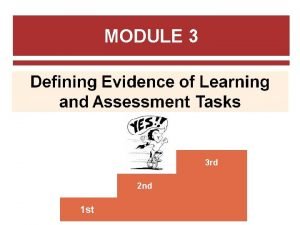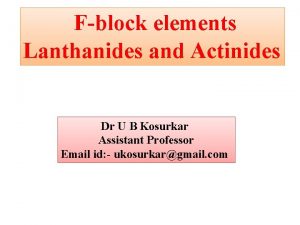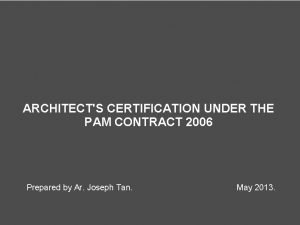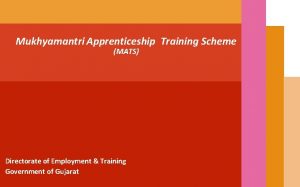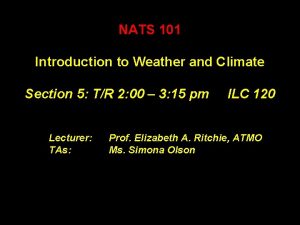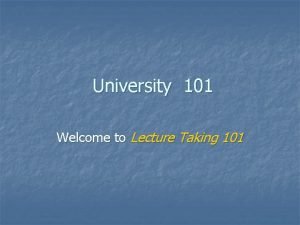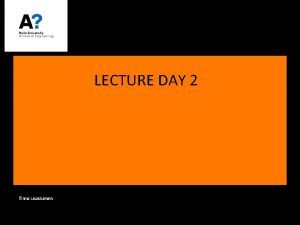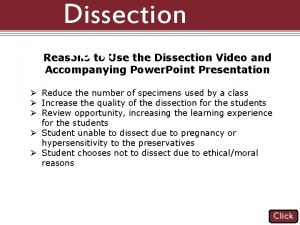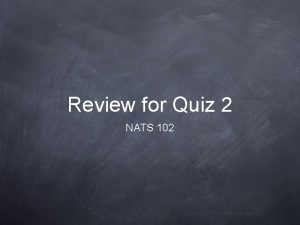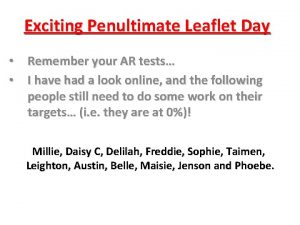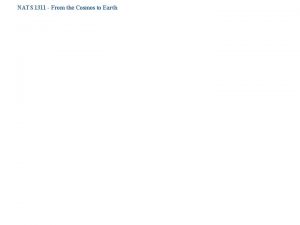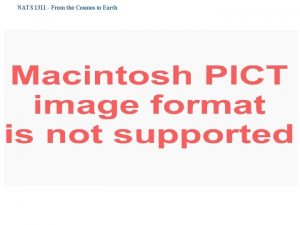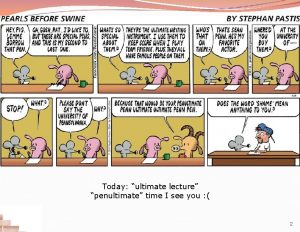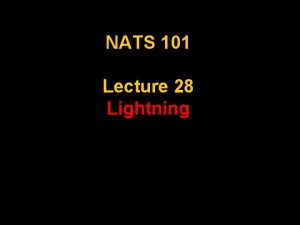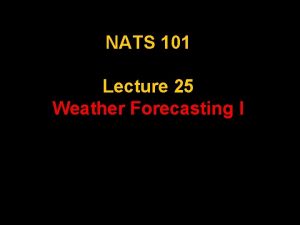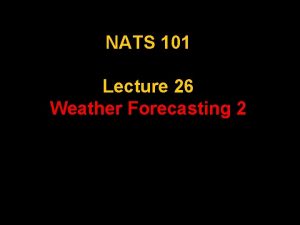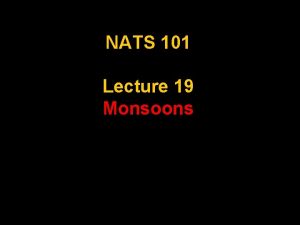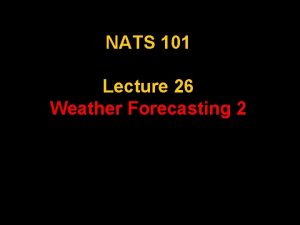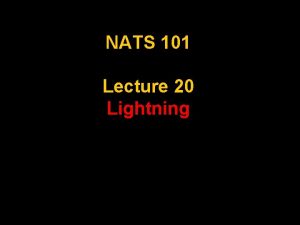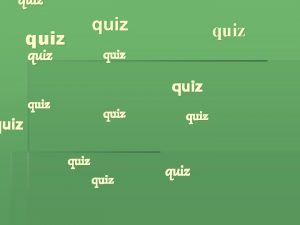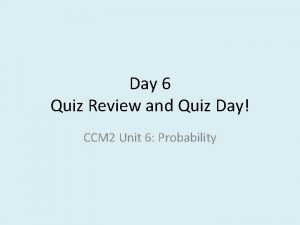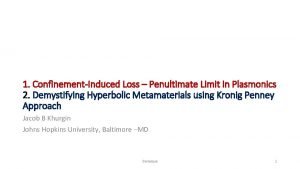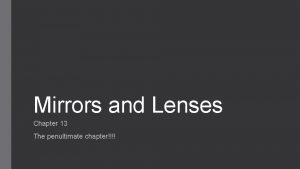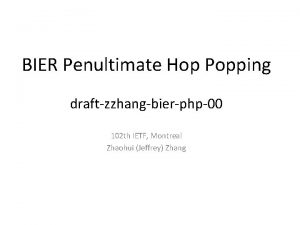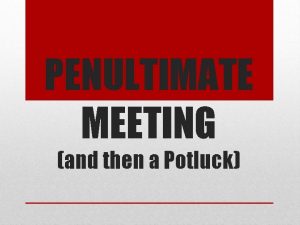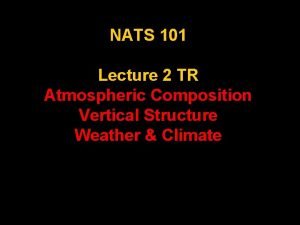NATS 101 Lecture 35 Penultimate Day Review Quiz




























- Slides: 28

NATS 101 Lecture 35 Penultimate Day Review

Quiz Answer Keys • Answer keys for all of the quizzes (except the upcoming one!) will be posted on the homepage sometime this afternoon. • The old quizzes are very useful study guide since 40 questions on the Final Exam will be verbatim copies of prior quiz questions. • And speaking of the Final Exam…

Final Exam Exemptions • During class on Wednesday, 7 Dec 2005, written statements will be issued to students who earned an exemption from the final per criteria in the course syllabus. • To qualify for an exception, a student must have accumulated a total of 126 or more correct answers on all of their in class quizzes and pop quizzes. 90% 140 (7 quizzes 20 questions) = 126!

Final Exam Exemptions • The student must attend class on that day to receive their written exemption. • This will be only time and place that exemptions will be issued. • While this might seem overly intolerant, it keeps the situation manageable for me. No Show Wednesday = No Exemption!

Final Exam Exemptions • In lieu of taking the final exam, a qualified student can chose to hand in their exception statement with their signature immediately following class on 7 Dec 2005. • This is the only procedure that a student can use to “cash in” their exemption. NO EXCEPTIONS! (So Please…Don’t Even Ask)

Final Exam Exemptions • A tally of those students who qualify for an exemption will be complete by next class. • If you believe you have qualified for an exception but your name is not announced next class, then you must prove the mistake. • You do this by coming to my office ASAP. • Bring all of your graded quizzes. I can then verify if a mistake was made and issue, if needed, an exception (and apology!).

How to Challenge Your Final Grade • Keep all of your graded quizzes until the beginning of next term. Why? • It is your only proof that a mistake was made on your final grade. • It is your burden to prove a mistake.

How to Challenge Your Final Grade • If you believe a mistake was made, then come to my office early next semester and bring all of your graded quizzes. • I can then verify whether mistake was made and issue, if necessary, a grade change and a major suck-up apology!

Review Topics Chapter 1 • Weather Maps – Surface Plots/Maps – Upper Air Plots/Maps • Atmospheric Composition – Primary Gases – Trace Gases • Vertical Structure – Height Pressure, Density, Temperature – Troposphere, Stratosphere, Mesosphere, etc.

Review Topics Chapter 2 and 3 • Temperature – Scales, Molecular Meaning • Heat Transfer – Conduction, Convection, Radiation • Radiation – Wien’s Law, Stephan-Boltzmann Law • Greenhouse Effect – Selective absorption and emission

Review Topics Chapter 2 and 3 • Diurnal Temperature Range – Time of Maximum and Minimum – Heat Balance Relationships and Time Lag • Seasons – Primary Cause: Tilt of Earth’s Axis • Length of Day, Beam Spreading – Heat Balance and Time Lag

Review Topics Chapter 4 • Moisture – Partial Pressure, Saturation Vapor Pressure – How Water Vapor is Measured and Parameters – How Condensation Occurs – Latent Heat Release • Clouds – Fog Types and Mechanisms – Cloud Types: Height and Vertical Development

Review Topics Chapter 5 • Stability – Stable, Unstable, Conditionally Unstable – Dry and Moist Adiabatic Lapse Rates, – Environmental Lapse Rate and Stability • Precipitation Processes – Collision-Coalescence, Warm Clouds – Ice Crystal Process, Mixed Clouds – Accretion (Riming)-Splintering-Aggregation – Rain, Freezing Rain, Sleet, Snow

Review Topics Chapter 6 • Atmospheric Pressure – Ideal Gas Law – Reduction of Surface Pressure to Sea Level • Surface Maps, Upper Air Maps – Surface Isobars at Mean Sea Level – Upper Air Heights of Isobaric Surfaces

Review Topics Chapter 6 • Newton Law – Accelerated Frame of Reference – Coriolis Force – Geostrophic Balance and Winds • Surface Winds, Vertical Motion – Friction – Curved Flow Gradient Wind – Divergence-Convergence Vertical Motion

Review Topics Chapter 7 • Diurnal Winds – Land-Sea Breeze – Mountain-Valley Breeze – Thermally Direct Circulation • Monsoons: Annual Reversal Wind – Analogue of Land-Sea Breeze – Asia Monsoon Strongest – Mexican Monsoon – Thermally Direct Circulation

Review Topics Chapter 7 • Global Circulation – Equator-Pole Temperature Difference – Thermally Direct Circulation – 3 -Cell Circulation Earth’s Rotation • Hadley, Ferrell, Polar • Relation to Climate Zones • Air-Sea Interactions – Upwelling – El Nino

Review Topics Chapter 8 • Air Masses – Classified by Source Region • Continental-Maritime, Tropics-Polar – Characteristic Weather • Fronts – Types: Cold, Warm, Stationary, Occluded – Characteristic Weather and Structure

Review Topics Chapter 8 • Midlatitude Cyclones – Caused by Temperature Gradients – Role of Upper-Level Divergence – Structure • Trough tilts toward the west with increasing height

Review Topics Chapter 9 • Weather Forecasting – Simple Types • Persistence, Trend, Analog Climatology – Numerical Weather Prediction • Computer models • Why all Forecasts Go Awry – NWP shortcomings – Chaos

Review Topics Chapter 10 • Thunderstorms – Types: Air Mass, Severe, Supercell – Role of Downdraft – Climatology • Lightning and Thunder – In-Cloud versus Cloud-to-Ground – Sequence for Cloud-to-Ground Stroke – Cause of Thunder – Speed of Sound

Review Topics Chapter 10 • Tornadoes – Cause • Tilting of Rotation from horizontal to vertical axis – Characteristic Weather – Climatology – Damage

Review Topics Chapter 11 • Hurricanes – Cause: Energy from Warm Ocean – Structure – Development Sequence – Climatology – Damage • Winds, Rain Flooding, Coastal Storm Surge

Review Topics Chapter 12 • Air Pollution – Primary Pollutants • CO, NO, SO 2, VOC’s, PM – Secondary Pollutants • H 2 SO 4, NHO 3, NO 2, O 3, SMOG – Pollution Weather • Inversion, Weak Winds, Sunny, Hot • Ventilation Factor – Acid Rain • p. H Rain (5. 6 Pristine)

Review Topics Chapter 12 • Ozone Hole – Natural balance of stratospheric ozone – How CFC ‘s disrupt balance- chlorine atoms • CFC Sources, Resident Time – Special conditions exist in Antarctica – Annual cycle of Ozone Hole

Review Topics Chapter 14 • Natural Climate Variability – Climate always changes – Use proxy data to reconstruct past climate – CO 2 -temperature relationship – Mechanisms of climate change • Milankovich Theory of Ice Ages • Continental Drift on Geologic Time Scales – Complexity of climate – Positive and Negative Feedback

Review Topics Chapter 14 • Anthroprogenic Climate Variability – Confident of warming past 150 years – How much (if any) is man-made? – Mechanism: CO 2 and Greenhouse effect – Use climate models to produce future climates – 1% per annum CO 2 increases produce • 2 C temperature rise • Precipitation much more uncertain – Key policy and planning questions?

Assignment Next Lecture • Announce Final Exemptions • Overview of Final Exam • Information on “What Score on Final is Needed to Improve Course Grade”? • Student Course Evaluations
 Day 1 day 2 day 3 day 4
Day 1 day 2 day 3 day 4 Anti penultimate shell
Anti penultimate shell Anti penultimate shell
Anti penultimate shell Penultimate certificate
Penultimate certificate Mats apprentice
Mats apprentice Nats weather
Nats weather Day 1 day 2 day 817
Day 1 day 2 day 817 01:640:244 lecture notes - lecture 15: plat, idah, farad
01:640:244 lecture notes - lecture 15: plat, idah, farad Physics 101 lecture notes pdf
Physics 101 lecture notes pdf Lecture 101
Lecture 101 Physics 101 lecture 1
Physics 101 lecture 1 Physics 101 lecture notes pdf
Physics 101 lecture notes pdf Waves pdf download
Waves pdf download Lecture day
Lecture day Dissection 101 sheep heart quiz
Dissection 101 sheep heart quiz Dissection 101 sheep heart quiz
Dissection 101 sheep heart quiz Dissection 101
Dissection 101 William beanes elementary school
William beanes elementary school Ocean the part day after day
Ocean the part day after day Day to day maintenance
Day to day maintenance As your room gets messier day by day, entropy is
As your room gets messier day by day, entropy is Tomorrow i dont know
Tomorrow i dont know Romeo and juliet timeline activity
Romeo and juliet timeline activity Growing day by day
Growing day by day Observation of seed germination day by day
Observation of seed germination day by day Germination conclusion
Germination conclusion Geotropism
Geotropism I live for jesus day after day
I live for jesus day after day Dying he saved me buried he carried
Dying he saved me buried he carried

